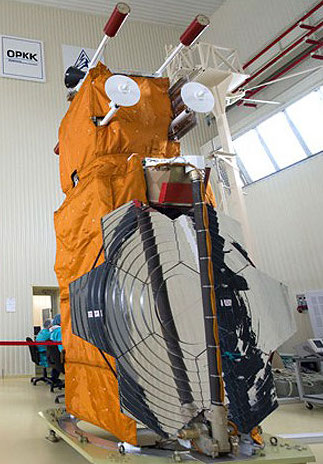
The Mikhailo Lomonosov 300 (MVL-300) mission
was a Russian high-energy astrophysics satellite. It was named to honor the
300th anniversary of the birth of the Russian polymath Mikhail
Vasilyevich Lomonosov. It was designed by the M. V. Lomonosov Moscow State
University (MGU; itself named after the same intellectual). The
mission’s purpose was the study gamma-ray bursts
at multiple wavelengths, and study transient phenomena in the Earth’s
upper atmosphere.
The mission was launched on April 28, 2016 from the Russian Vostochny
(Eastern) spacedrome into a polar sun-synchronous orbit aboard the Soyuz 2-1a
Volga rocket.
The spacecraft bus was based on the mission-proven Kanopus platform.
Lomonosov originally had a three year planned lifespan, but roughly ten months
shy of that milestone, the data transmission system failed and specialists
from MGU and VNIIEM Corporation (the satellite builder) were unable to restore
operations.
MVL-300 was equipped with many instruments for high-energy physics and
astronomy research. The BDRG, ShOK, and UFFO instruments were those primarily
engaged in studies of gamma-ray bursts and X-ray astrophysical phenomena.
- The Blok Detektirovaniya Rentgenovskogo e Gamma izlycheniya (BDRG;
X-ray and Gamma-ray Detection Unit), a trio of X-ray/gamma-ray detectors
mounted perpendicularly to each other. It was designed for studying a wide
variety of X-ray and gamma-ray celestial sources, and to generate trigger
signals for the ShOK instrument for gamma-ray bursts.
- The Opticheckiye Kameri Svepkhirokogo Polya Ereniya (ShOK;
Ultra-wide Field of View Optical Cameras), a pair of optical camera with
very wide fields of view. By taking several images
per second, the cameras could track space debris, light flashes such as
sprites, novae, supernovae, near-Earth asteroids, and gamma-ray bursts.
- The Ultra-Fast Flash Observatory (UFFO) consisted of two instruments, the
UFFO Burst Alert and Trigger telescope (UBAT), and Slewing Mirror Telescope
(SMT). UBAT was a coded mask aperature X-ray camera with a wide
(∼1.95 sr; 90.2° x 90.2°) with
a 191.2 cm2 effective area and energy resolution of 2 keV at
60 keV. UBAT would trigger an alert to the SMT, which would slew onto the
target within a second of the alert, collecting UV and optical afterglow
without requiring the satellite to reorient. The telescope provided a
17 arcmin field of view with a 0.5 arcsec location accuracy.
- The Dozimetr Elektronov, PROtonov, Neutronov (DEPRON; Electron,
Proton, and Neutron
Dosimeter) which measured the intensity and energy of high-energy particles in the ambient
cosmic radiation enviroment of the spacecraft.
- The Trekovaya UStanovka (TUS; Ultraviolet Tracking Detector),
a 1.8 m2 concentrator mirror
with an array of near-UV sensitive photomultiplier tubes to study the night
side of the Earth, looking for cosmic-ray air shower tracks from interactions
with the Earth’s atmosphere. It also monitored very short-lived events
such as “vertical lightning” and similar transient phenomena.
The mirror was made of carbon material for durability in the harsh thermal
environment, and coated with MgF2 to protect it from atmospheric
oxygen.
The Lomonosov mission studied cosmic rays at extremely high energies
(1019–1020 eV) in search of the predicted
GZK spectral cutoff, detected and studied gamma-ray burst sources, as well
as upper atmospheric energic events, including local weather-induced events
(e.g. “sprites”s from active thunderstorms), magnetospheric events,
and air shower events from cosmic rays striking the Earth’s upper
atmosphere.